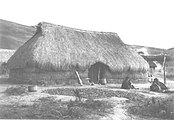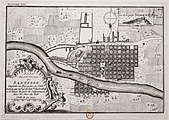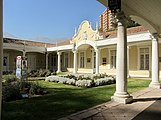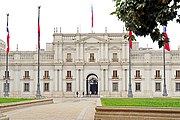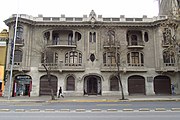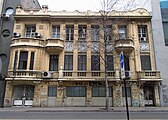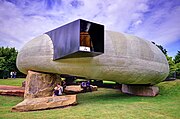
Santiago, also known as Santiago de Chile, is the capital and largest city of Chile and one of the largest cities in the Americas. It is located in the country's central valley and is the center of the Santiago Metropolitan Region, which has a population of 7 million, representing 40% of Chile's total population. Most of the city is situated between 500–650 m (1,640–2,133 ft) above sea level.

Palacio de La Moneda, or simply La Moneda, is the seat of the President of the Republic of Chile. It also houses the offices of three cabinet ministers: Interior, General Secretariat of the Presidency, and General Secretariat of the Government. Located in downtown Santiago, it occupies an entire block in the Civic District, bordered by Moneda street to the north, Morandé street to the east, Alameda del Libertador Bernardo O'Higgins to the south, and Teatinos street to the west.

Spanish Colonial architecture represents Spanish colonial influence on New World and East Indies' cities and towns, and it is still seen in the architecture as well as in the city planning aspects of conserved present-day cities. These two visible aspects of the city are connected and complementary. The 16th-century Laws of the Indies included provisions for the layout of new colonial settlements in the Americas and elsewhere.

Neoclassical architecture, sometimes referred to as Classical Revival architecture, is an architectural style produced by the Neoclassical movement that began in the mid-18th century in Italy and France. It became one of the most prominent architectural styles in the Western world. The prevailing styles of architecture in most of Europe for the previous two centuries, Renaissance architecture and Baroque architecture, already represented partial revivals of the Classical architecture of ancient Rome and ancient Greek architecture, but the Neoclassical movement aimed to strip away the excesses of Late Baroque and return to a purer and more authentic classical style, adapted to modern purposes.

Inca architecture is the most significant pre-Columbian architecture in South America. The Incas inherited an architectural legacy from Tiwanaku, founded in the 2nd century B.C.E. in present-day Bolivia. A core characteristic of the architectural style was to use the topography and existing materials of the land as part of the design. The capital of the Inca empire, Cuzco, still contains many fine examples of Inca architecture, although many walls of Inca masonry have been incorporated into Spanish Colonial structures. The famous royal estate of Machu Picchu is a surviving example of Inca architecture. Other significant sites include Sacsayhuamán and Ollantaytambo. The Incas also developed an extensive road system spanning most of the western length of the continent and placed their distinctive architecture along the way, thereby visually asserting their imperial rule along the frontier.

The balconies of Lima are items of cultural heritage built during the Viceroyalty of Peru and the Republic of Peru. Most of these balconies are of the Viceroyalty period, built in the late 17th and 18th centuries, are located in the Historic Center of Lima. They were adapted for residential purposes and have influenced the lives of many Peruvian scholars such as the 19th century writer Ricardo Palma.

The architecture of Argentina can be said to start at the beginning of the Spanish colonisation, though it was in the 18th century that the cities of the country reached their splendour. Cities like Córdoba, Salta, Mendoza, and also Buenos Aires conserved most their historical Spanish colonial architecture in spite of their urban growth.
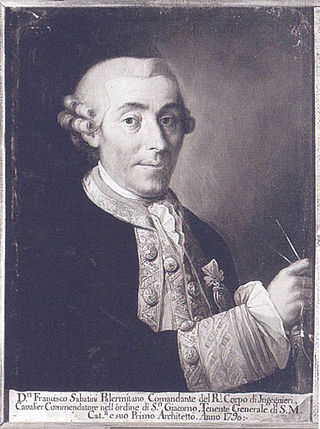
Gioacchino Toesca e Ricci was an Italian architect who worked at the service of the Spanish Empire, mainly in Chile. He was mainly a Neoclassical architect although he also built Baroque buildings.

Spanish Baroque is a strand of Baroque architecture that evolved in Spain, its provinces, and former colonies.
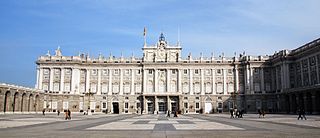
Spanish architecture refers to architecture in any area of what is now Spain, and by Spanish architects worldwide. The term includes buildings which were constructed within the current borders of Spain prior to its existence as a nation, when the land was called Iberia, Hispania, or was divided between several Christian and Muslim kingdoms. Spanish architecture demonstrates great historical and geographical diversity, depending on the historical period. It developed along similar lines as other architectural styles around the Mediterranean and from Central and Northern Europe, although some Spanish constructions are unique.

Peruvian architecture is the architecture carried out during any time in what is now Peru, and by Peruvian architects worldwide. Its diversity and long history spans from ancient Peru, the Inca Empire, Colonial Peru to the present day.

Portuguese architecture refers to both the architecture of Portugal's modern-day territory in Continental Portugal, the Azores and Madeira, as well as the architectural heritage/patrimony of Portuguese architects and styles throughout the world, particularly in countries formerly part of the Portuguese Empire.
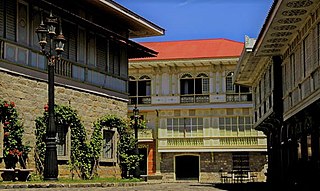
The architecture of the Philippines reflects the historical and cultural traditions in the country. Most prominent historic structures in the archipelago are influenced by Austronesian, American architectures.
Colombia's architectural heritage includes Spanish colonial architecture including Catholic churches. Its modern architecture represents various International Style architecture. In the postmodern architecture era a wave of innovate and striking buildings have been designed.

The architecture of Mexico reflects the influences of various cultures, regions, and periods that have shaped the country's history and identity. In the pre-Columbian era, distinct styles emerged that reflected the distinct cultures of the indigenous peoples of Mexico, particularly in the architecture of Mesoamerica. During the colonial era, the region was transformed by successive styles from Europe. With the foremost style during this era being Mexican Baroque.

Santiago Metropolitan Cathedral is the seat of the Archdiocese of Santiago de Chile and the main temple of the Catholic Church in that country. As a Cathedral Church, it is the permanent seat of the Archbishop of Santiago and is dedicated to the Assumption of the Virgin Mary.

The Peruvian colonial architecture, developed in the Viceroyalty of Peru between the 16th and 19th centuries, was characterized by the importation and adaptation of European architectural styles to the Peruvian reality, yielding an original architecture.
The architecture of Costa Rica includes remains from the pre-Columbian Era, all the way to modern buildings that form part of the nation's contemporary infrastructure. There is a unique architectural landscape present in Costa Rica that is reflective of the nation's history and vibrant culture. The nation encompasses an array of historical buildings from both the pre-colonial era and post-colonial era, such as Guayabo and the Basilica of Our Lady of the Angels. The contemporary architectural scene in Costa Rica has also captured global attention, exemplified by structures such as Casa Flotanta. Architecture in Costa Rica is reflective of the nation's environmental conservation policies. This is reflected in the distinctive and extensive presence of canopy bridges throughout the nation, constructed in the aim of preventing rainforest destruction.

The architecture of Bolivia is closely related to its history, culture and religion. Bolivian architecture has been constantly changing and progressing over time. Subject to terrain and high altitudes, most of Bolivia's Pre-Columbian buildings were built for housing, mainly influenced by Bolivian indigenous culture. The arrival of Spanish settlers brought many European-style buildings, and the Spaniards began planning to build big cities. After Independence, the architectural style became Neoclassical and many churches and government buildings were built. In modern Bolivia, like many countries, skyscrapers and post-modern buildings dominate, and of course there are special styles of architecture to attract tourists and build.

The Iglesia de las Agustinas is a Catholic church, located in downtown Santiago, Chile. The church was declared as a National Monument in 1977.



